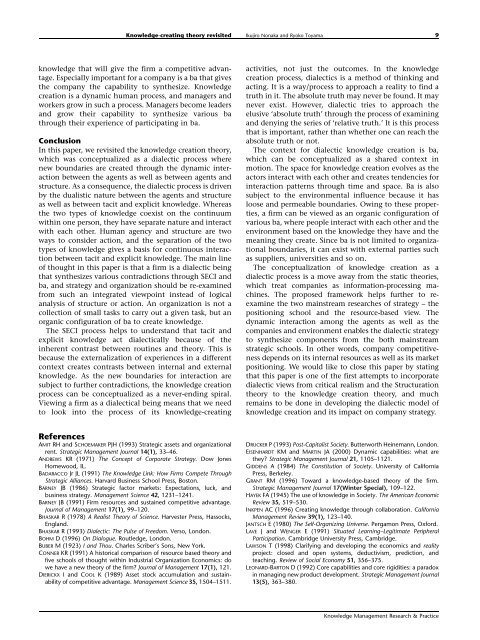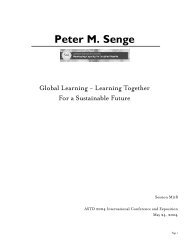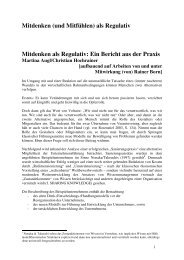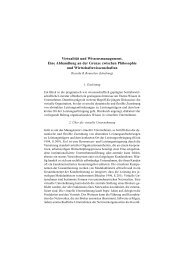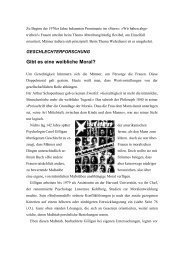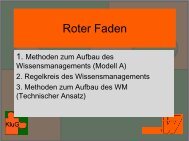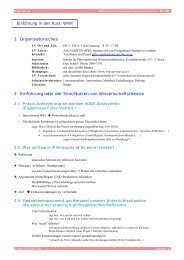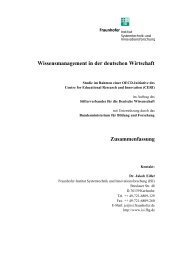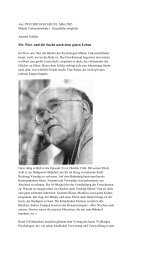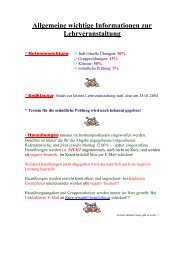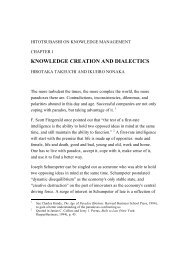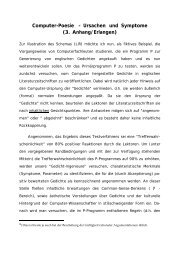The knowledge-creating theory revisited: knowledge creation as a ...
The knowledge-creating theory revisited: knowledge creation as a ...
The knowledge-creating theory revisited: knowledge creation as a ...
You also want an ePaper? Increase the reach of your titles
YUMPU automatically turns print PDFs into web optimized ePapers that Google loves.
Knowledge-<strong>creating</strong> <strong>theory</strong> <strong>revisited</strong> Ikujiro Nonaka and Ryoko Toyama 9<br />
<strong>knowledge</strong> that will give the firm a competitive advantage.<br />
Especially important for a company is a ba that gives<br />
the company the capability to synthesize. Knowledge<br />
<strong>creation</strong> is a dynamic human process, and managers and<br />
workers grow in such a process. Managers become leaders<br />
and grow their capability to synthesize various ba<br />
through their experience of participating in ba.<br />
Conclusion<br />
In this paper, we <strong>revisited</strong> the <strong>knowledge</strong> <strong>creation</strong> <strong>theory</strong>,<br />
which w<strong>as</strong> conceptualized <strong>as</strong> a dialectic process where<br />
new boundaries are created through the dynamic interaction<br />
between the agents <strong>as</strong> well <strong>as</strong> between agents and<br />
structure. As a consequence, the dialectic process is driven<br />
by the dualistic nature between the agents and structure<br />
<strong>as</strong> well <strong>as</strong> between tacit and explicit <strong>knowledge</strong>. Where<strong>as</strong><br />
the two types of <strong>knowledge</strong> coexist on the continuum<br />
within one person, they have separate nature and interact<br />
with each other. Human agency and structure are two<br />
ways to consider action, and the separation of the two<br />
types of <strong>knowledge</strong> gives a b<strong>as</strong>is for continuous interaction<br />
between tacit and explicit <strong>knowledge</strong>. <strong>The</strong> main line<br />
of thought in this paper is that a firm is a dialectic being<br />
that synthesizes various contradictions through SECI and<br />
ba, and strategy and organization should be re-examined<br />
from such an integrated viewpoint instead of logical<br />
analysis of structure or action. An organization is not a<br />
collection of small t<strong>as</strong>ks to carry out a given t<strong>as</strong>k, but an<br />
organic configuration of ba to create <strong>knowledge</strong>.<br />
<strong>The</strong> SECI process helps to understand that tacit and<br />
explicit <strong>knowledge</strong> act dialectically because of the<br />
inherent contr<strong>as</strong>t between routines and <strong>theory</strong>. This is<br />
because the externalization of experiences in a different<br />
context creates contr<strong>as</strong>ts between internal and external<br />
<strong>knowledge</strong>. As the new boundaries for interaction are<br />
subject to further contradictions, the <strong>knowledge</strong> <strong>creation</strong><br />
process can be conceptualized <strong>as</strong> a never-ending spiral.<br />
Viewing a firm <strong>as</strong> a dialectical being means that we need<br />
to look into the process of its <strong>knowledge</strong>-<strong>creating</strong><br />
activities, not just the outcomes. In the <strong>knowledge</strong><br />
<strong>creation</strong> process, dialectics is a method of thinking and<br />
acting. It is a way/process to approach a reality to find a<br />
truth in it. <strong>The</strong> absolute truth may never be found. It may<br />
never exist. However, dialectic tries to approach the<br />
elusive ‘absolute truth’ through the process of examining<br />
and denying the series of ‘relative truth.’ It is this process<br />
that is important, rather than whether one can reach the<br />
absolute truth or not.<br />
<strong>The</strong> context for dialectic <strong>knowledge</strong> <strong>creation</strong> is ba,<br />
which can be conceptualized <strong>as</strong> a shared context in<br />
motion. <strong>The</strong> space for <strong>knowledge</strong> <strong>creation</strong> evolves <strong>as</strong> the<br />
actors interact with each other and creates tendencies for<br />
interaction patterns through time and space. Ba is also<br />
subject to the environmental influence because it h<strong>as</strong><br />
loose and permeable boundaries. Owing to these properties,<br />
a firm can be viewed <strong>as</strong> an organic configuration of<br />
various ba, where people interact with each other and the<br />
environment b<strong>as</strong>ed on the <strong>knowledge</strong> they have and the<br />
meaning they create. Since ba is not limited to organizational<br />
boundaries, it can exist with external parties such<br />
<strong>as</strong> suppliers, universities and so on.<br />
<strong>The</strong> conceptualization of <strong>knowledge</strong> <strong>creation</strong> <strong>as</strong> a<br />
dialectic process is a move away from the static theories,<br />
which treat companies <strong>as</strong> information-processing machines.<br />
<strong>The</strong> proposed framework helps further to reexamine<br />
the two mainstream researches of strategy – the<br />
positioning school and the resource-b<strong>as</strong>ed view. <strong>The</strong><br />
dynamic interaction among the agents <strong>as</strong> well <strong>as</strong> the<br />
companies and environment enables the dialectic strategy<br />
to synthesize components from the both mainstream<br />
strategic schools. In other words, company competitiveness<br />
depends on its internal resources <strong>as</strong> well <strong>as</strong> its market<br />
positioning. We would like to close this paper by stating<br />
that this paper is one of the first attempts to incorporate<br />
dialectic views from critical realism and the Structuration<br />
<strong>theory</strong> to the <strong>knowledge</strong> <strong>creation</strong> <strong>theory</strong>, and much<br />
remains to be done in developing the dialectic model of<br />
<strong>knowledge</strong> <strong>creation</strong> and its impact on company strategy.<br />
References<br />
AMIT RH and SCHOEMAKER PJH (1993) Strategic <strong>as</strong>sets and organizational<br />
rent. Strategic Management Journal 14(1), 33–46.<br />
ANDREWS KR (1971) <strong>The</strong> Concept of Corporate Strategy. Dow Jones<br />
Homewood, IL.<br />
BADARACCO Jr JL (1991) <strong>The</strong> Knowledge Link: How Firms Compete Through<br />
Strategic Alliances. Harvard Business School Press, Boston.<br />
BARNEY JB (1986) Strategic factor markets: Expectations, luck, and<br />
business strategy. Management Science 42, 1231–1241.<br />
BARNEY JB (1991) Firm resources and sustained competitive advantage.<br />
Journal of Management 17(1), 99–120.<br />
BHASKAR R (1978) A Realist <strong>The</strong>ory of Science. Harvester Press, H<strong>as</strong>socks,<br />
England.<br />
BHASKAR R (1993) Dialectic: <strong>The</strong> Pulse of Freedom. Verso, London.<br />
BOHM D (1996) On Dialogue. Routledge, London.<br />
BUBER M (1923) I and Thou. Charles Scriber’s Sons, New York.<br />
CONNER KR (1991) A historical comparison of resource b<strong>as</strong>ed <strong>theory</strong> and<br />
five schools of thought within Industrial Organization Economics: do<br />
we have a new <strong>theory</strong> of the firm? Journal of Management 17(1), 121.<br />
DIERICKX I and COOL K (1989) Asset stock accumulation and sustainability<br />
of competitive advantage. Management Science 35, 1504–1511.<br />
DRUCKER P (1993) Post-Capitalist Society. Butterworth Heinemann, London.<br />
EISENHARDT KM and MARTIN JA (2000) Dynamic capabilities: what are<br />
they? Strategic Management Journal 21, 1105–1121.<br />
GIDDENS A (1984) <strong>The</strong> Constitution of Society. University of California<br />
Press, Berkeley.<br />
GRANT RM (1996) Toward a <strong>knowledge</strong>-b<strong>as</strong>ed <strong>theory</strong> of the firm.<br />
Strategic Management Journal 17(Winter Special), 109–122.<br />
HAYEK FA (1945) <strong>The</strong> use of <strong>knowledge</strong> in Society. <strong>The</strong> American Economic<br />
Review 35, 519–530.<br />
INKPEN AC (1996) Creating <strong>knowledge</strong> through collaboration. California<br />
Management Review 39(1), 123–140.<br />
JANTSCH E (1980) <strong>The</strong> Self-Organizing Universe. Pergamon Press, Oxford.<br />
LAVE J and WENGER E (1991) Situated Learning–Legitimate Peripheral<br />
Participation. Cambridge University Press, Cambridge.<br />
LAWSON T (1998) Clarifying and developing the economics and reality<br />
project: closed and open systems, deductivism, prediction, and<br />
teaching. Review of Social Economy 51, 356–375.<br />
LEONARD-BARTON D (1992) Core capabilities and core rigidities: a paradox<br />
in managing new product development. Strategic Management Journal<br />
13(5), 363–380.<br />
Knowledge Management Research & Practice


